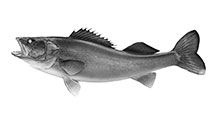
By Brett Larson, April 13, 2015
Ongoing concerns about the Mille Lacs walleye population mean this year’s tribal harvest will be limited to less than 12,000 pounds, down from 17,100 pounds last year.
The Minnesota DNR’s fall gillnet surveys — which are used to estimate the walleye population — showed improvement last year, but not enough to increase the allocation of walleyes for the state or the tribes. In fact, this year’s total harvest limit is down to 40,000 pounds from last year’s total of 60,000 pounds. Of the 40,000 pounds of walleye that can be harvested, state anglers will be allotted 28,600 pounds and tribal members 11,400.
Although final regulations have not been set, the bag limit for state anglers will probably remain at two. If anglers reach their quota, the DNR has said, anglers may be limited to catch-and-release fishing for walleyes.
Scientists believe that a number of factors may be contributing to the decline, including invasive species and climate change. They agree that tribal gillnetting is not a cause, because the problem is the survival of young fry into adulthood.
The DNR commissioned a “blue ribbon panel” of independent fisheries scientists from around the U.S. and Canada. They analyzed all the existing data and agreed with the Minnesota DNR that plenty of young walleyes are being born, but they are not making it through the first two years. Causes may include predation by northern pike and cormorants, and “cannibalism” by other walleyes, possibly due to improved water clarity or a shortage of tullibee.
One of the panel members, Paul Venturelli of the University of Minnesota, said, “Our independent review of DNR management of Mille Lacs reached similar conclusions as the agency. Mainly, more walleye are not surviving their first three years of life. It is unlikely that recreational or sustenance harvest is a root cause of this problem.”
Resorters, guides, and anglers around Mille Lacs continue to point fingers at gillnetting as the sole or primary cause of the decline, ignoring the fact that walleyes have gone through “boom and bust” cycles forever — long before the U.S. Supreme Court ruled that Bands could fish under their own regulations by traditional methods like spearing and netting. They also ignore other possible causes, like invasive species and climate change.
Their eagerness to blame netting seems to stem from a desire to end the tribal harvest rather than a sincere desire to help the lake.
At the February meeting of the Mille Lacs Fishery Input Group, members voted almost unanimously in favor of a petition brought by anti-netting activist Joe Fellegy.
Fellegy asked the DNR to tabulate the results and then asked DNR fisheries chief Don Pereira to read them aloud. When Don declined, Rocky Reef resort owner John Odle said, “It would sound better coming out of your mouth, Don.” Pereira declined again, so Fellegy read the results himself, and said, “This is the official vote of the lake input group.”
The discussion spun out of control when Odle was quoted in the Star Tribune saying, “This is devastating. It’s going to affect the whole economy. There are businesses being lost every year on this lake. Our livelihoods are in your hands.’’ Odle has been operating a successful resort on the lake for more than 15 years and has made many similar comments in the years since.
According to those in attendance, members also sarcastically questioned whether Bands are living up to their claim to be “stewards of the resource.”
Some members of the group proposed a “walleye replacement program” — basically “buying out” the Bands’ allocations by providing them with frozen walleye from other lakes.
Another member suggested a boycott of Grand Casinos.
Some members of the group — including owners of Twin Pines and Red Door resorts — took the DNR to court last year, claiming that the state agency was not doing its job under the Minnesota “right to hunt and fish” amendment. The state District Court and Court of Appeals ruled in favor of the DNR and against the resorters. Some of the most successful resorters on the lake, like Odle, have been among the most vocal in complaining that the tribal harvest is hurting business.
Decline of old-style “mom and pop” resorts is not unique to Mille Lacs, nor are slot limits or “boom and bust” walleye cycles. Traditional resorts around the state have gone out of business as the demands of tourists have changed.
Other groups in the area, like the Mille Lacs Area Tourism Council, are trying to deal with those changes by promoting a variety of activities in the region, like gaming, cultural tourism, wildlife watching, and fishing for smallmouth bass, muskies, and northerns.